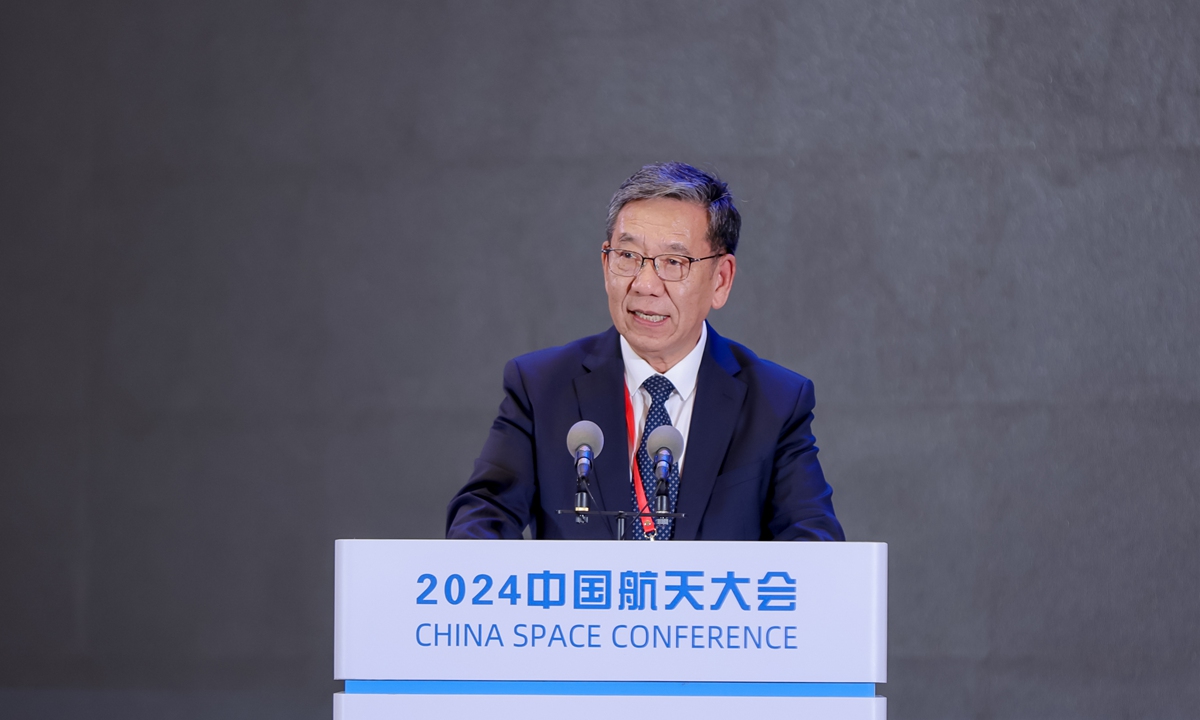China to launch 3 lunar probe missions within next 4 yrs; ILRS to complete basic form before 2035: chief designer of lunar exploration projects

Wu Weiren, chief designer of chief designer of China’s lunar exploration project gives a speech at the 2024 China Space Conference in Wuhan on April 24, 2024. Photo: courtesy of China Space Conference
China will carry out three Chang'e lunar probe missions within next four years and the basic form of the International Lunar Research Station (ILRS,) the international moon base project currently led by the China National Space Administration and Russia's ROSCOSMOS, is expected to be completed before 2035, Wu Weiren, chief designer of China's lunar exploration project, revealed during a speech at the ongoing China Space Conference in Wuhan, Central China's Hubei Province.
Wu, who is also the chief scientist and director of China's Deep Space Exploration Laboratory (DSEL,) and an academician at the Chinese Academy of Engineering, remarked at the annual space conference to mark the Space Day of China on April 24 every year that as an important task during the basic construction phase of the ILRS, Chang'e-6 mission will be launched soon to complete a sampling mission and return from the lunar far side; Chang'e-7 is scheduled for launch around 2026 to conduct environmental and resource surveys at the lunar south pole; Chang'e-8 is planned for launch around 2028 to conduct in-situ resource utilization experiments on the moon.
In recent years, China's space technology capabilities have made significant strides, establishing major infrastructure for deep space exploration and establishing cooperation with multiple countries worldwide, all of which lay a solid foundation for the construction of the ILRS.
Following the principles of "overall planning, step-by-step implementation, and building while using," the construction of the ILRS will be carried out in two phases.
By 2035, the basic version will be completed, centered around the lunar south pole, with comprehensive scientific facilities equipped with basic functions and elements, conducting regular scientific experiments and a certain scale of resource development and utilization.
By 2045, the expanded version will be completed, with the lunar orbit station as the hub, featuring fully equipped and substantially scaled facilities, stable operations, while conducting comprehensive scientific research on the moon and in-depth resource development and utilization, and conducting technical verification and scientific experiments related to a manned mission to Mars.
The ILRS consists of lunar surface, lunar orbit, and ground segments, comprising infrastructure such as energy and power systems, command and information systems, and lunar transportation systems, with functions including energy supply, central control, communication and navigation, lunar-earth transportation, and lunar surface research, enabling long-term and sustained scientific exploration, resource development, and technology verification across multiple disciplines and objectives.
The ILRS, initiated by China and Russia, is being jointly developed and constructed by multiple countries, with long-term autonomous operation on the lunar surface and in lunar orbit, with short-term human participation, as an expandable, maintainable comprehensive scientific experimental facility.
Wu also revealed that China plans to launch the Tianwen-2 mission around 2025, to carry out flyby exploration and return samples from a small asteroid located about 40 million kilometers away from Earth. Around 2030, Tianwen-3 is planned to be launched to execute a sample return mission from Mars, Wu said.
"Currently, looking at the progress of various countries around the world, our country is expected to become the first country to return samples from Mars," Wu remarked.
China has begun planning the construction of the world's first Mars sample laboratory and is also deepening the feasibility study of the Tianwen-4 mission, aiming for the exploration of Jupiter and its moons, followed by the arrival at Uranus, according to Wu.
"The probability of an asteroid impact on Earth is extremely low, but the consequences would be enormous," Wu said, noting that in history, asteroids have struck the Earth multiple times, resulting in major disasters such as the extinction of dinosaurs.
China has initiated an asteroid defense plan and is expected to implement a kinetic impact on an asteroid located tens of millions of kilometers away around 2027, altering its orbit and conducting impact assessment in orbit, aiming for precision, effectiveness, and clear evaluation, he said.
Wu disclosed that in the middle of this century, China plans to launch a new type of propulsion spacecraft, reaching the boundary of the solar system at 80-100 astronomical units (AU), conducting scientific exploration in the distant, dark, and cold unknown regions, aiming to establish new milestones in humanity's understanding of the universe.
Photos
Related Stories
- China joins hands with LatAm, Caribbean countries to explore space
- China unveils latest sci-tech challenges in astronautics
- Aerospace exhibition held in Wuhan to celebrate China' Space Day
- China facilitates developing nations to learn about space exploration
- China to launch Shenzhou XVIII crewed spaceship on April 25
- Wuhan Declaration adopted at China-Latin American and Caribbean States Space Cooperation Forum
Copyright © 2024 People's Daily Online. All Rights Reserved.









